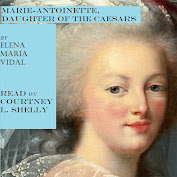
Madame Élisabeth of France and her companions leave the Conciergerie for the final journey to the guillotine on May 10, 1794. Madame Élisabeth was the last to die, which means she had to watch all the others decapitated before her. They each begged for her blessing before approaching the scaffold. From This is Versailles:
Once the condemned were removed, Madame Élisabeth once again exerted herself to the comfort of her fellow-condemned. She had always been a fervently religious woman and now she encouraged those who were to die with her. She chose to rejoice in the fact that the Tribunal had not asked them to renounce their faith "only their miserable lives".
There appears to be some conjecture about when Madame Élisabeth was definitely informed of the death of Marie Antoinette. Later, Marie Thérèse would recall that they had heard her mother's sentence being cried out from the people walking beneath their windows but that they had refused to believe it. One account claims that Élisabeth had asked to see her sister-in-law after her sentencing only to be told that she had suffered the same fate. Another claims that it was only at the foot of the guillotine that she overheard a callous remark. Once it was noticed that the condemned bowed to her before their deaths, a spectator allegedly remarked that that they could "make their salaams to her all they wanted, she will share the fate of the Austrian". (Read more.)
From European Royal History:
She reportedly successfully comforted and strengthened the morale of her fellow prisoners before their impending execution with religious arguments, and by her own example of calmness.
Élisabeth was executed along with the 23 men and women who had been tried and condemned at the same time as she, and reportedly conversed with Mme de Senozan and Mme de Crussol on the way. In the cart taking them to their execution, and while waiting her turn, she helped several of them through the ordeal, encouraging them and reciting the De profundis until her time came. Near the Pont Neuf, the white kerchief which covered her head was blown off, and thus being the only person with bare head, she attracted special attention by the spectators, and witnesses attested that she was calm during the whole process.
At the foot of the guillotine, there was a bench for the condemned who were to depart the cart and wait on the bench before their execution. Élisabeth departed the cart first, refusing the help of the executioner, but was to be the last to be called upon, which resulted in her witnessing the death of all the others.
Reportedly, she considerably strengthened the morale of her fellow prisoners, who all behaved with courage. When the last person before her, a man, gave her his bow, she said, “courage, and faith in the mercy of God!” and then rose to be ready for her own turn. While she was being strapped to the board, her fichu (a sort of shawl) fell off, exposing her shoulders, and she cried to the executioner “Au nom de votre mère, monsieur, couvrez-moi. (In the name of your mother, sir, cover me)”
Reportedly, her execution caused some emotion by the bystanders, who did not cry “Vive la Republique” at this occasion, which was otherwise common. The respect Élisabeth had enjoyed among the public caused concern with Robespierre, who had never wished to have her executed and who “dreaded the effect” of her death.
Her body was buried in a common grave at the Errancis Cemetery in Paris. At the time of the Restoration, her brother, Louis-Stanislas, Comte de Provence, now King Louis XVIII of France and Navarre, searched for her remains, only to discover that the bodies interred there had decomposed to a state where they could no longer be identified. Élisabeth’s remains, with that of other victims of the guillotine (including Robespierre, also buried at the Errancis Cemetery) were later placed in the Catacombs of Paris. A medallion represents her at the Basilica of Saint Denis.
Beatification
The Cause of Beatification of Élisabeth was introduced in 1924, but has not yet been completed. In 1953, she was declared a Servant of God, and in 2016, her Cause was re-opened. (Read more.)


















No comments:
Post a Comment